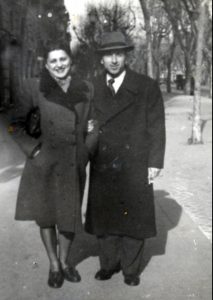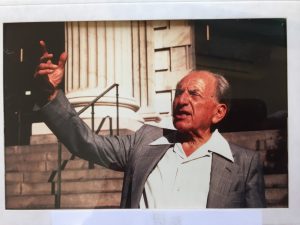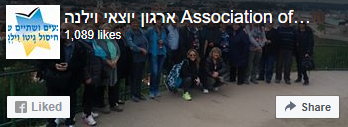Avraham Tory
1909-2001
Avraham Tory was born in 1909 in the town of Lazdijai, Lithuania. His father was Zerach Golub, a rabbi, and his mother was Leah Bat Yosef Prosek. He studied in a "heder" (a religious elementary school for Jewish children) established in the town at the end of the First World War. He later studied at the Hebrew Gymnasia in Marijampole, a regional center - the first Hebrew high school in Lithuania, where his Jewish and Zionist personality was formed.
At the age of 13, he began his activities in the "Maccabi" and Zionist youth movement.
In 1928 he began studying at the Lithuanian University in Kovno, and after a year went to study law at the University of Pittsburgh in the USA, during the Great Depression. He worked as a Hebrew teacher for a living. After a year and a half, following the death of his beloved father, he returned to Lithuania and continued his law studies there. He headed Beitaria, non-political Zionist student association. While holding this position, he often encountered hostility towards Jews from Lithuanian professors and students. He fought back and even instructed his fellow students to fight for their right and dignity.
In April 1932, he traveled to Eretz Israel at the head of a group of gymnasts from Lithuania to take part in the first Maccabiah held in Tel Aviv.
In 1933, he received a master's degree in law, giving him the right to practice law, but he could not exercise this right because the courts and prosecutors in the country were closed to Jews. In fact, the chances of Jewish jurists obtaining a license to practice law were almost nil. Tory was able to complete an internship with a fellow Christian student who graduated with him and received the same diploma as his own and who was appointed a judge. He assisted Avraham thanks to their joint sporting activities.
Until the Soviet occupation in 1940, he was very active as a member of the Maccabi Center in Lithuania, as its general secretary, and as acting guide of the Zionist National Youth Movement, and as a member of the Zionist Center in Lithuania.
He participated as a delegate at the 21st Jewish Congress in Geneva in 1939. At that time, the German army invaded Poland. Despite this, he returned to Lithuania, to which Jewish refugees from Poland began to flow. He was very active in the Refugee Committee on behalf of the General Zionists in Lithuania.
In October 1939, the Soviet occupation of Lithuania began, followed by annexation to the USSR and a campaign to "purge all anti-revolutionary elements" including Jewish organizations and newspapers. An emergency Israeli office was established that distributed certificates to Zionist activists who were in danger. In it, Avraham represented the General Zionist B. These certificates were not honored by the government. Zionist leaders were arrested or sent to Siberia, and Avraham fled to Vilna, where he hid. Seeing that even there he was in danger, he returned to Kovno after eight days.
On June 22, 1941, the Germans entered Lithuania. He tried to escape on his bike from Kovno, but after days of wandering and tens of miles of hard riding, he discovered that the Germans were everywhere and there was no escape. He returned to Kovno where many Jews had already been abducted, butchered, and brutally murdered.
He then began to document the horror, as he did later regarding the events that befell Lithuanian Jews in general and himself in particular.
In Kovno, the Jewish community with the Chief Rabbi, Rabbi Duber Kahana Shapira began organizing itself, and Avraham, along with two other young lawyers like him, volunteered to assist the committee. He was then close to the difficult historical events that took place and could document them firsthand.
He was one of the four founders of the Marijampole and Kovno Zionist Center underground in the ghetto. Parallel to his public activities, he continued to write his journal and collect documents, maps, and drawings, and hid them out of a deep sense of the need to document the events of the period, and out of fear that he would not survive. In this mission, he was assisted by Pnina Sheinzon, later his wife. She encouraged and supported him, and helped him to archive the material, and later to take it and smuggle it to Israel. Before leaving the ghetto, he hid all the material in five boxes that he buried in the ground and attached to each of them a will in which he asked to transfer the material to the Zionist Representation of Lithuanian Jews, if any, or in case no Zionist body would be established in Lithuania after the war, to deliver it to the directorate of the World Zionist Organization in Jerusalem.
He managed to escape the ghetto in the spring of 1944 and hid with a Christian family in the village. After the liberation by the Soviet army he returned to Kovno, where he found three of the five crates he had hidden.
The journal and all the material he had stored, served as central evidence in the trials of Nazi and Lithuanian war criminals. These are still used today as important historical documents. The manuscripts and the original documents were displayed at the Holocaust Museum in Washington from 1997-1999, and later donated to Yad Vashem. The journal was translated into Hebrew, English and Lithuanian and published by Bialik Institute Publishing House (1988), Harvard Publishing House (1990) and the Lithuanian Government Press (2000).
With the end of the war and liberation, he recovered with incredible speed, arrived in Rome, as part of the "escape" organized by the Jewish community in Eretz-Israel and the Brigade and began extensive public activity. He established the office of the Diaspora Center for Israel - a center that worked for refugees flowing from all occupied European countries with the goal of bringing them to the Land of Israel-Palestine. It was still under the British Mandate and closed to Jews.
When he immigrated to Israel in 1947, he continued his activities. Despite various offers made to him for public employment, he chose to establish his profession as an attorney. He converted the license he had to work in Israel, and at the same time engaged in extensive public activity on a voluntary basis, working first as a clerk and later as an attorney.
For 20 years he served as honorary secretary of Maccabi World, was one of the founders of the village of Maccabiah, participated in the organization of the Maccabiahs in Israel and even in South America.
He was a member of the Zionist General Council presidency, the Masua and Friends of Beit Hatfutsot administrations, and received many accolades for his work.
He was one of the founders of the International Organization of Jewish Lawyers and Jurists and a member of its presidency.
A warm and cordial Jew, ready to help anyone, he devoted much of his time to helping new immigrants with their absorption in the country and more than once gave them and others pro bono legal services. He was one of the first to rescue Jews from the USSR and Siberia.
He died in peace at the age of 92, surrounded by many family members — his wife, daughters, grandchildren, and great-grandchildren, as well as many friends who cherished and loved him.
Written by the family.
Avraham Tory, 92; Diary Told of Nazi Brutality in Lithuania/Los Angeles Times by Dennis McLellan 23/3/2002
After German troops rolled into the central Lithuania city of Kovno in June 1941, 30,000 of the city’s 37,000 Jews who hadn’t escaped or been killed were herded into a ghetto. For the next three years, Nazi edicts ruled their lives--and their deaths.
“From now on, the Germans declare that any pregnant woman will be killed on the spot,” read one edict.
“Jews must pull all wagons themselves, including funeral hearses,” read another.
“The mother and sister of the hanged Meck [an escapee] must be taken to the Ninth Fort for execution,” read yet another.
By war’s end, all but about 3,000 of Kovno’s Jews had perished, many in mass executions. But a record of their lives--and deaths--survived to tell their story.
Avraham Tory, a Jewish lawyer who risked his own life by keeping a detailed diary and gathering official Nazi documents that bore witness to what happened to the doomed inhabitants of the Kovno ghetto, died of natural causes Feb. 24 at his home in Tel Aviv. He was 92.
As deputy secretary of the Jewish Council of Elders, which administered the Germans’ rules in the ghetto, Tory was able to record the German decrees and regulations, council deliberations and conversations with Nazi officials in his diary.
“Every day, I put into writing what my eyes had seen and my ears had heard, and what I had experienced personally,” Tory later wrote.
Working with other council members, he collected Nazi documents, orders, warnings, notices and commands that documented what he wrote in his diary, as well as gathering clandestine photographs and artist’s drawings made by ghetto inhabitants who witnessed Nazi atrocities.
Tory buried all of the documentation in five wooden crates beneath a ghetto apartment house, inserting into each box a note, written in Yiddish:
“With awe and reverence I am hiding in this crate what I have written, noted and collected with thrill and anxiety, so that it may serve as material evidence--'corpus delecti'--accusing testimony when the Day of Judgment comes.”
In case none of Kovno’s Jews survived the war, Tory instructed a Lithuanian priest to dig up the crates and forward them to the World Zionist Organization.
Couple Escaped Into Countryside
Tory, along with his fiance, managed to escape the ghetto to a hiding place in the countryside in the spring of 1944. They returned to Kovno after Soviet troops occupied the city in August. Tory later smuggled out his diary and the most important documents, which he had buried in a rucksack.
His diary, which is among the most comprehensive surviving official Holocaust diaries, was later used in war-crime deportation hearings against the mayor of Kovno and the SS ergeant who personally directed the mass murder of 9,200 Kovno Jewish men, women and children in what was called the Great Action.
“He wrote the diary because he wanted to leave evidence so that the world would know what the Germans did,” Tory’s wife, Pnina, said by phone from Tel Aviv on Tuesday. “He was a very brave man.”
She was equally brave, keeping the latest pages of Tory’s diary in her room and sometimes writing down what he dictated to her.
The Torys, who were married in August 1944 after the liberation of Kovno, had planned to flee Lithuania together. But when Tory received word in February 1945 that he was going to be sent to Siberia, he was forced to immediately leave alone.
His wife and her young daughter from a previous marriage left about three weeks later and joined him in Poland.
After arriving In Israel in 1947, Tory practiced law and became secretary general of the International Assn. of Jewish Lawyers and Jurors.
In 1988, his diary was published in Hebrew. Two years later, it was published in English as “Surviving the Holocaust: The Kovno Ghetto Diary.”
“It is a painful document,” a Chicago Tribune reviewer wrote, “its pages a collage of retold events, scraps of news, official German directives, firsthand testimonies, whiffs of rumor and terror.”
In one passage of the diary, Tory writes of the morning roll call on Oct. 28, 1941, by Nazi SS Master Sgt. Helmut Rauca, in which he condemned to death entire families with a simple wave or a nod.
“From time to time,” Tory wrote, "[he] feasted on a sandwich--wrapped in wax paper lest his bloodstained hands get greasy--or enjoyed a cigarette.”
The next morning, more than 9,000 Jewish men, women and children were gunned down at the edge of a deep pit.
“In every house a void had been created,” Tory wrote. “The homes, the furniture, and the belongings of the victims ... seemed to exude the odor of death. Hardly anyone dared touch them or make use of them.”
Emotions Delayed Diary’s Publishing
Pnina Tory said it took so long for her husband’s diary to be published “because when we got to Israel, it was like fire for him to touch it. He didn’t speak about the Holocaust because it was so emotional. He couldn’t get over it for a long time.”
Tory’s diary formed the basis for “Hidden History of the Kovno Ghetto,” an exhibition at the U.S. Holocaust Memorial Museum in Washington from 1997 to 1999.
“This community of individuals was essentially destroyed by the Germans,” said museum Director Sara Bloomfield. “But the effort Tory led and what he did through his diary created a legacy for that community that no longer existed.”
Bloomfield said people in other Jewish ghettos had tried to document things. But Tory’s writing “is certainly important because it is so meticulous. He was a lawyer, so there was precision of language, as if he were preparing evidence for a trial.”
Tory’s diary also inspired a documentary, “Kovno Ghetto: A Buried History.” The original diary pages are housed at Yad Vashem in Jerusalem.
Tory was born Avraham Golub in Lazdijai, Lithuania in 1909. After high school, he came to America to study law at the University of Pittsburgh, but returned to Lithuania after his father’s death and continued studying law at the University of Kovno. He competed as a gymnast in the first Maccabi Games in Tel Aviv in 1932. As a young attorney, he was active in Zionist politics there.
In addition to his wife, Tory is survived by three daughters who also live in Israel, Shulamit Karbi, Alina Tory and Tzila Magdassi; six grandchildren; and 12 great-grandchildren.






